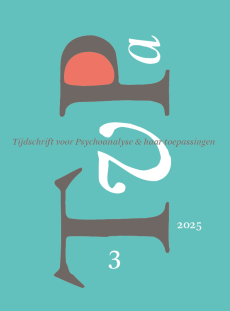Structurele verandering
Summary
Structural change
Structural change implies change at the level of the implicit inner working model, and also a shift from unsafe to safe attachment. In other words: structural change implies an increase in mentalising ability, or reflective functioning. Change at the level of mental representations implies a decrease in conflicting mental representations. Next to this, structural change implies an increase in integrated self-object relational dyads, procedurally consolidated in the implicit inner working model, in which representations are defined more in terms of mutual involvement than of isolation and conflict. Structural change means increased flexibility in using alternative options.
Key words:
personality change, psychoanalysis, psychotherapy
Literatuur
- Bateman, A.W. & Fonagy, P. (1999). The effectiveness of partial hospitalization in the treatment of borderline personality disorder – A randomised controlled trial. The American Journal of Psychiatry, 156, 1563-1569.
- Britton, R. (1995). Psychic reality and unconscious belief. International Journal of Psychoanalysis, 76, 19-23.
- Erle, J. & Goldberg, D. (1984). Observations on assessment of analyzability by experienced analysts. Journal of the American Psychoanalytic Association, 32, 715-737.
- Fonagy, P. (1995). Playing with reality: the development of psychic reality and its malfunction in borderline patients. International Journal of Psychoanalysis, 76, 39-44.
- Fonagy, P. (1999). The process of change and the change of processes: What can change in a ‘good’ analysis? Keynote-lezing, voorjaarsvergadering, division 39 van de American Psychological Association, New York 16 april 1999.
- Fonagy, P., Moran, G.S., Edgcumbe, R., Kennedy, H., Target, M. (1993). The roles of mental representations and mental processes in therapeutic action. The Psychoanalytic Study of the Child, 48, 9-48.
- Fonagy, P. & Target, M. (1996). Playing with reality: 1. Theory of mind and the development of psychic reality. International Journal of Psychoanalysis, 77, 217-233.
- Horowitz, M.J., Kernberg, O.F., Weinshel, E.M. (red.) (1993). Psychic Structure and Psychic Change. Madison CT: International Universities Press.
- Kernberg, O. (1992). Aggression in personality disorders and perversions. New Haven: Yale University Press.
- Kris, A.O. (1993). Support and Psychic Structural Change. In M.J. Horowitz, O.F. Kernberg, E.M. Weinshel (red.), Psychic Structure and Psychic Change (p. 95-116). Madison: International Universities Press.
- Perry, J.C. (1995). A pilot study of defenses in long-term psychotherapy. Paper, gepresenteerd op de jaarvergadering van de American Psychiatric Association, Miami.
- Rangell, L. (1993). The Psychoanalytic Theory of Change. In M.J. Horowitz, O.F. Kernberg, E.M. Weinshel (red.), Psychic Structure and Psychic Change (p. 159-190). Madison CT: International Universities Press.
- Rapaport, D. (1957). The Theory of Ego Autonomy. In M. Gill, The collected papers of David Rapaport (p. 685-709). New York: International Universities Press, 1960.
- Rapaport, D. & Gill, M. (1959). The points of view and assumptions of metapsychology. International Journal of Psychoanalysis, 40, 153-162.
- Sandell, R., Blomberg, J., Sandell, R., Lazar, A., Carlsson, J. e.a. (1997). Findings of the Stockholm Outcome of Psychotherapy and Psychoanalysis Project (STOPP). Paper, gepresenteerd op de jaarvergaderingvan de Society for Psychotherapy Research, Geilo, Noorwegen.
- Sandler, J. & Sandler, A.M. (1993). Psychoanalytic Technique and Theory of Psychic Change. In M.J. Horowitz, O.F. Kernberg, E.M. Weinshel (red.), Psychic Structure and Psychic Change (p. 57-76). Madison CT: International Universities Press.
- Treurniet, N. (1993). Support of the Analytical Process and Structural Change. In M.J. Horowitz, O.F. Kernberg, E.M. Weinshel (red.), Psychic Structure and Psychic Change (p. 191-232). Madison CT: International Universities Press.
- Wallerstein, R.S. (1986) Forty-two Lives in Treatment: A Study of Psychoanalysis and Psychotherapy. New York: Guilford Press.
 © 2009-2025 Uitgeverij Boom Amsterdam
© 2009-2025 Uitgeverij Boom Amsterdam
ISSN 1382-516x
De artikelen uit de (online)tijdschriften van Uitgeverij Boom zijn auteursrechtelijk beschermd. U kunt er natuurlijk uit citeren (voorzien van een bronvermelding) maar voor reproductie in welke vorm dan ook moet toestemming aan de uitgever worden gevraagd:
Behoudens de in of krachtens de Auteurswet van 1912 gestelde uitzonderingen mag niets uit deze uitgave worden verveelvoudigd, opgeslagen in een geautomatiseerd gegevensbestand, of openbaar gemaakt, in enige vorm of op enige wijze, hetzij elektronisch, mechanisch door fotokopieën, opnamen of enig andere manier, zonder voorafgaande schriftelijke toestemming van de uitgever.
Voor zover het maken van kopieën uit deze uitgave is toegestaan op grond van artikelen 16h t/m 16m Auteurswet 1912 jo. Besluit van 27 november 2002, Stb 575, dient men de daarvoor wettelijk verschuldigde vergoeding te voldoen aan de Stichting Reprorecht te Hoofddorp (postbus 3060, 2130 KB, www.reprorecht.nl) of contact op te nemen met de uitgever voor het treffen van een rechtstreekse regeling in de zin van art. 16l, vijfde lid, Auteurswet 1912.
Voor het overnemen van gedeelte(n) uit deze uitgave in bloemlezingen, readers en andere compilatiewerken (artikel 16, Auteurswet 1912) kan men zich wenden tot de Stichting PRO (Stichting Publicatie- en Reproductierechten, postbus 3060, 2130 KB Hoofddorp, www.cedar.nl/pro).
No part of this book may be reproduced in any way whatsoever without the written permission of the publisher.
Nieuwsbrief Boom Psychologie
Meld u nu aan en ontvang maandelijks de Boom Psychologie nieuwsbrief met aantrekkelijke aanbiedingen en de nieuwe uitgaven.
Aanmelden


